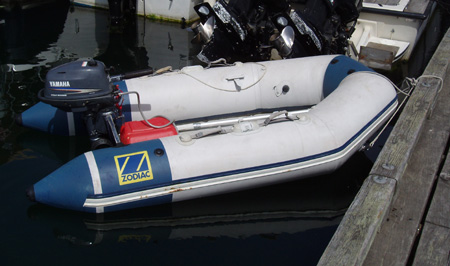Inflatable Dinghies
Lower Cost Light Duty Inflatable Boats That Are Great For Occasional Use Or As A Tender
Inflatable dinghies are safe, fun, low cost and a great way to get out boating!
A dinghy is a small boat carried or towed by a larger vessel to be used for off ship excursions or docking.
A dinghy can also be called a tender.
By definition, a dinghy is a secondary boat.

A secondary boat does not need to be as rugged and durable as a boat that is getting used as a primary boat.
A primary boat would be the only boat you have, or the boat that is the primary mode of transportation for whatever great adventure you are on.
A dinghy is a light duty boat. Read more about
light duty boats here.
I think of dinghies as light duty boats. They can be collapsible or roll-up inflatable boats with or without a transom, with or without a keel, but there is no uniform use of the term dinghy.
Some companies distinguish dinghies as flat bottom boats without a transom, other companies call flat bottom boats rafts, others call them soft tails.
Small ribs are often called dinghies as well. You can read more about
ribs on this page.
So don't get too hung up on the name dinghy, it means different things to different people.
Roll up dinghies have aluminum slats or wood slats for a floor, or the newer high pressure inflatable floors. Roll up boats may be flat bottomed, or they may have an inflatable keel, or the keel may be formed by a V shaped inflatable floor.
Collapsible or foldable inflatable dinghies have sectional floors of aluminum, wood or plastic. To read more about the different types of floors found in these boats
read this page.
Inflatable boats generally called dinghies come in the smaller end of the size range - 6'/1.8m to 14'/4.3m.
The durability factor gets to be more of an issue when you get into the larger sizes because the extra forces from heavier loads and larger motors will cause premature wear on a boat with a light duty construction. This is the area where many buyers - and sellers - get confused.
Because dinghies are light duty and built for occasional use or for short trips to shore, they are cheaper to build and cost less to buy.
We purchased an inflatable boat, by way of a seller's recommendation, that was just a large light duty inflatable boat in construction and durability.
Anyone (dealer or private seller) that tells you a light duty boat will stand up to regular use as your primary boat is..... well....... how can I say this nicely.......
.... perhaps they just don't know the difference themselves.
If your primary use for a boat is to go fishing with a small motor and if you never plan to travel very far with a full load. Then yes, a light duty inflatable boat, an inflatable dinghy, will work.
If you want to regularly go on long day runs with a full load of passengers, or head out on 2 week long camping trips on the ocean, with the boat full of gear, or 10 day fishing trips with a full complement of camping and fishing gear, then a dinghy may be too light duty for your intended use.
The selling feature for us was that the light duty boat cost less. At the time I didn't know the difference between light duty boats and sport boats (more durable boats).
I like spending less money if possible too! But it cost me later when I had to change our boat to match our use.
Some models of inflatable dinghies are: